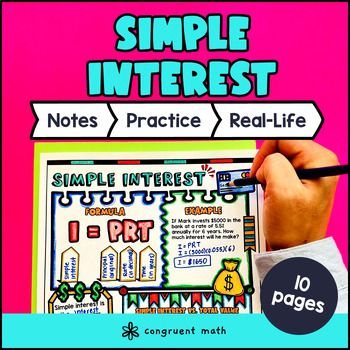Want more ideas and freebies?
Get my free resource library with digital & print activities—plus tips over email.
Join for free resources →
$4.25

$4.25
After this lesson, students will be able to:
Before this lesson, students should be familiar with:
As a hook, ask students why understanding simple interest is important in real life financial situations. For example, you could ask them why it's important to know how much interest they will have to pay on a loan or how much they will earn in interest on a savings account. You can also refer to the last page of the guided notes and the FAQs for additional ideas.
Use the first page of the guided notes to introduce the topic of simple interest and the formula I = PRT. Explain that simple interest is the amount of money earned or paid on a principal amount over a certain period of time, and the formula allows us to calculate that amount. Walk through the key points of the formula and provide examples of how to use it to calculate simple interest. Use the first page of the guided notes to introduce the terms principal, rate, and time, and explain their role in the formula. Emphasize that the principal is the initial amount of money, the rate is the interest rate expressed as a decimal, and the time is the period over which the interest is calculated. Use the second page of the guided notes to explain the difference between calculating simple interest and total balance. Go through the word problems together.
Refer to the FAQ below for a walk-through on this, as well as ideas on how to respond to common student questions.
Based on student responses, reteach any concepts that students need extra help with. If your class has a wide range of proficiency levels, you can pull out students for reteaching, and have more advanced students begin working on the practice exercises.
Have students practice calculating simple interest and total balance using the practice sheets in the guided notes resource (page 2). Walk around to answer student questions.
Fast finishers can dive into the maze activity (page 3) and color by number activity (page 4) for extra practice. You can assign it as homework for the remainder of the class.
Bring the class back together, and introduce the concept of simple interest in real-life scenarios. Refer to the last page of the guided notes resource where students read about how simple interest is used in car loans.
Explain that simple interest is often used in financial situations such as loans, investments, and credit cards. It helps determine how much money is earned or paid for borrowing or investing a certain amount of money.
To provide a specific example, discuss the concept of car loans. Explain that when someone wants to buy a car but doesn't have enough money to pay for it upfront, they can take out a car loan from a bank or other financial institution. The bank will lend them the money to buy the car, but the borrower will have to pay back the loan over a period of time with additional interest.
Encourage students to share any personal experiences or brainstorm ideas related to loans and simple interest. This will help make the concept more relatable and engaging for them.
If you’re looking for digital practice for simple interest, try my Pixel Art activities in Google Sheets. Every answer is automatically checked, and correct answers unlock parts of a mystery picture. It’s incredibly fun, and a powerful tool for differentiation.
Here are 3 activities to explore:
A fun, no-prep way to practice simple interest is Doodle Math — they’re a fresh take on color by number or color by code. It includes multiple levels of practice, perfect for a review day or sub plan.
Here are 2 activities to try:
Simple interest is the amount of money that is charged or earned on a loan or investment, based on the initial amount of money (principal), the interest rate, and the time period.
To calculate simple interest, you can use the formula I = PRT, where:
The principal in simple interest refers to the initial amount of money that is borrowed or invested. It is the starting amount on which the interest is calculated.
To find the total balance in simple interest, you need to add the principal to the simple interest. The formula is: Total balance = Principal + Simple interest.
Multistep percent problems involve solving problems that require multiple steps and calculations to find the answer. These problems often involve using percentages in combination with other mathematical operations, such as addition, subtraction, multiplication, or division.
To solve multistep percent problems, you need to break down the problem into smaller steps and solve each step individually. Here are some strategies you can use:
Certainly! One example of a real-life application of simple interest is car loans. When someone buys a car with a loan, they usually have to pay back the borrowed money (principal) along with an additional amount of money (interest) over a certain period of time. The interest rate determines how much extra the borrower has to pay.
To differentiate instruction for students who may struggle with simple interest, you can:
Get my free resource library with digital & print activities—plus tips over email.
Join for free resources →